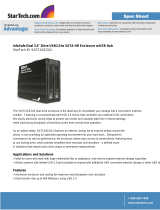
Dell™ PowerEdge™ R710 Technical Guidebook
5
THE DELL™ POWEREDGE™ R710
The Dell PowerEdge R710 is designed to be the cornerstone of today’s competitive enterprise.
Engineered in response to input from IT professionals, it is the next-generation 2U rack server
created to eciently address a wide range of key business applications. The successor to the
PowerEdge 2950 III, the R710 runs the Intel
®
Xeon
®
5500 Series Processors and helps you lower
the total cost of ownership with enhanced virtualization capabilities, improved energy eciency,
and innovative system management tools.
Strong IT Foundation
As an IT professional, you want a data center built to allow for organic growth and the ability to scale
based on your company’s changing requirements. You need complete solutions that allow you to
focus your time and money on managing and growing your business. Dell understands your needs and
responds with an expanding portfolio of enterprise servers, storage technologies, and services with a
single goal: to help you simplify IT.
Purposeful Design
The R710 takes advantage of Dell’s system commonality. Once your IT managers learn one system, they
understand how to manage next-generation Dell servers. Logical component layout and power supply
placement also provide a straightforward installation and redeployment experience. Featuring 18 DIMM
slots and 4 integrated network connections, the R710 delivers the critical components to virtualization
and database performance. The Intel Xeon Processor 5500 Series adapts to your software in real time,
processing more tasks simultaneously. Using Intel
®
Turbo Boost Technology, the R710 can increase
performance during peak usage periods. You can then help reduce operating costs and energy usage
with Intel
®
Intelligent Power Technology, which proactively puts your server into lower power states when
demand decreases. Increased memory slots also save money by enabling you to use smaller,
less-expensive DIMMs to meet your computing needs.
Enhanced Virtualization
Featuring Intel Xeon-based architecture, embedded hypervisors, large memory capacity, and integrated
I/O, the next-generation Dell PowerEdge R710 delivers better overall system performance and greater
virtual machine-per-server capacity. With optional factory-integrated virtualization capabilities, you get
tailored solutions – built with the latest technologies from Dell and our trusted partners – which allow
you to streamline deployment and simplify virtual infrastructures. Choose your hypervisor from market
leaders such as VMware
®
, Citrix
®
, and Microsoft
®
, and enable virtualization with a few mouse clicks.
Energy-Optimized Technologies
Using the latest Energy Smart technologies, the R710 reduces power consumption while increasing
performance capacity versus the previous generation servers. Enhancements include ecient power
supply units right-sized for system requirements, improved system-level design eciency, policy-driven
power and thermal management, and highly ecient standards-based Energy Smart components. Dell's
advanced thermal control delivers optimal performance at minimal system and fan power consumption
resulting in our quietest 2U servers to date. These enhancements maximize energy eciency across our
latest core data center servers without compromising enterprise performance.
Simplified Systems Management
Gain more control with the next-generation Dell OpenManage™ suite of management tools. These tools
provide enhanced operations and standards-based commands designed to integrate with existing
systems for eective control. Dell Management Console (DMC) helps simplify operations and creates
stability by shrinking infrastructure management to one console. This console delivers a single view and
a common data source into the entire infrastructure management. Built on Symantec
®
Management
Platform, it has an easily extensible, modular foundation that can provide basic hardware management
all the way up to more advanced functions, such as asset and security management. Dell Management
Console reduces or eliminates manual processes, enabling you to save time and money for more





















